Related Research Articles
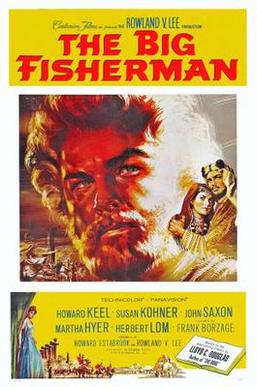
The Big Fisherman is a 1959 American historical drama film directed by Frank Borzage about the life of Simon Peter, one of the disciples of Jesus. Starring Howard Keel, Susan Kohner and John Saxon, the production is adapted from the 1948 novel, The Big Fisherman (book) by Lloyd C. Douglas. The film was shot at Universal-International studios but released by Buena Vista, the film releasing company of Walt Disney Productions.

Leonard Michael Maltin is an American film critic, film historian, and author. He is known for his book of film capsule reviews, Leonard Maltin's Movie Guide, published annually from 1969 to 2014. Maltin was the film critic on Entertainment Tonight from 1982 to 2010. He currently teaches at the USC School of Cinematic Arts and hosts the weekly podcast Maltin on Movies. He served two terms as President of the Los Angeles Film Critics Association, and votes for films to be selected for the National Film Registry.
Une Femme ou Deux is a French screwball comedy romance film released in 1985. It was directed by Daniel Vigne, who was also the screenwriter along with Élisabeth Rappeneau. It stars Gérard Depardieu, Sigourney Weaver, and Dr. Ruth Westheimer.

Vestron Video was the main subsidiary of Vestron, Inc., a home video company based in Stamford, Connecticut, that was active from 1981 to 1993, and is considered to have been a pioneer in the home video market.

Class Reunion is a 1982 American black comedy film produced by National Lampoon as the third film from the magazine. It was the second film released; although National Lampoon Goes to the Movies was filmed in 1981, it was delayed and not released until 1982.

Alienator is a 1990 science fiction film directed by Fred Olen Ray, produced by Jeffrey C. Hogue, and starring Jan-Michael Vincent.

I Was a Teenage Frankenstein is a horror film starring Whit Bissell, Phyllis Coates and Gary Conway, released by American International Pictures (AIP) in November 1957 as a double feature with Blood of Dracula. It is the follow-up to AIP's box office hit I Was a Teenage Werewolf, released less than five months earlier. Both films later received a sequel in the crossover How to Make a Monster, released in July 1958. The film stars Whit Bissell, Phyllis Coates, Robert Burton, Gary Conway and George Lynn.

Loving is a 1970 American comedy-drama film released by Columbia Pictures and directed by Irvin Kershner. It is based on the novel Brooks Wilson Ltd. written by pulp magazine illustrator John McDermott under his pen name J.M. Ryan. The movie starred George Segal in the lead role of a philandering illustrator and Eva Marie Saint as his wife. The cast included Sterling Hayden, David Doyle, Keenan Wynn, Roy Scheider, and Sherry Lansing. Broadway actress Betsy von Furstenberg has a small uncredited role, one of only two motion pictures she ever appeared in.
Stigma is a 1972 American drama film. It was produced by Charles Moss, while David E. Durston was both the writer and the director. Prominent themes in the film include racism and sexually transmitted disease. It stars Philip Michael Thomas in an early screen appearance, twelve years before he starred in the popular 1980s TV show Miami Vice.

The Midnight Hour is a 1985 American made-for-television comedy horror film directed by Jack Bender and starring Shari Belafonte-Harper, LeVar Burton, Peter DeLuise, and Dedee Pfeiffer. Its plot focuses on a small New England town that becomes overrun with zombies, witches, vampires, and all the other demons of hell after a group of teenagers unlocks a centuries-old curse on Halloween.

Leonard Maltin's Movie Guide was a book-format collection of movie capsule reviews that began in 1969, was updated biannually after 1978, and then annually after 1986. The final edition was published in September 2014. It was originally called TV Movies, which became Leonard Maltin's TV Movies and Video Guide, and then Leonard Maltin's Movie and Video Guide, before arriving at its final title. Film critic Leonard Maltin edited it and contributed a large portion of its reviews.
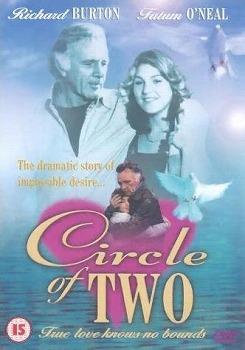
Circle of Two is a 1981 Canadian drama film starring Richard Burton and Tatum O'Neal. It was the last film directed by acclaimed film noir director Jules Dassin. O'Neal - sixteen at the time of filming - appears topless in one scene.

The Mountain Men is a 1980 American adventure Western film directed by Richard Lang and starring Charlton Heston and Brian Keith. Heston's son, Fraser Clarke Heston, wrote the screenplay.
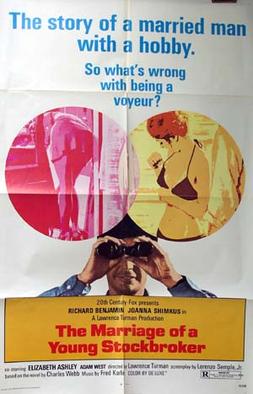
The Marriage of a Young Stockbroker is a 1971 American romantic comedy-drama film produced and directed by Lawrence Turman and written by Lorenzo Semple Jr., based on a novel of the same title by Charles Webb. Turman had produced 1967's high-grossing hit The Graduate, also adapted from a book by Webb.
Steven Henry Scheuer was a film and television historian and critic. He edited all seventeen editions of Movies on TV published between 1958 and 1993 and wrote The Movie Book (1974), subtitled A Comprehensive, Authoritative, Omnibus Volume on Motion Pictures and the Cinema World. He was moderator of the syndicated television series All About TV from 1969 to 1990. In 2002, he hosted and produced a 13-program series for public television, Television in America: An Autobiography.
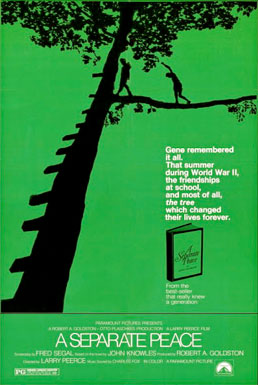
A Separate Peace is a 1972 American drama film directed by Larry Peerce. It was adapted by John Knowles and Fred Segal from Knowles's best-selling novel, about the conflicted friendship of two boarding-school students. The film stars Parker Stevenson and John Heyl.
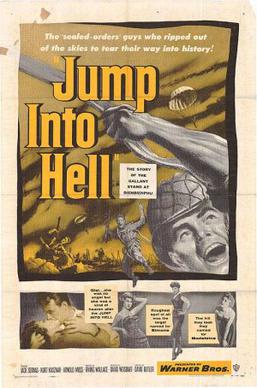
Jump into Hell is a 1955 war film directed by David Butler. The film stars Jacques Sernas and Kurt Kasznar. As the first Hollywood film based on the war in French Indochina, the story is a fictionalized account of the Battle of Dien Bien Phu.

Time Runner is a 1993 Canadian science fiction film directed by Michael Mazo, starring Mark Hamill, Rae Dawn Chong and Brion James. Hamill plays a 21st century soldier who is unwittingly teleported to 1992, and teams up with a scientist to prevent an alien race from gaining an advantage in its future war against mankind.
Rob Hedden is an American screenwriter and film director.
References
- 1 2 "Area Showtimes". The News-Messenger. Fremont. November 20, 1986. p. Time Out 3 – via newspapers.com (subscription required).
- 1 2 3 4 Zuckerman, Faye (March 23, 1985). "Vestron launches Feature Film Division" (PDF). Billboard Magazine . Vol. 97, no. 12. New York: Billboard Publications. p. 22. ISSN 0006-2510.
- 1 2 Canton, Rolf (2007). "Producers: Patrick Wells". Behind the cameras: Minnesotans in the Movies, Volume II. Minneapolis: Micawber's. p. 22. ISBN 9781932472530.
- ↑ Green, Paul (2016). Encyclopedia of Weird Westerns. McFarland & Company. p. 227. ISBN 9781476662572.
- ↑ Brennan, Sandra (2007). "Space Rage (1986)". Movies & TV Dept. The New York Times . Archived from the original on November 24, 2007. Retrieved November 6, 2009.
- 1 2 3 "Psychologist becomes a filmmaker on a dare". The Daily Press. Victorville. Associated Press. May 17, 1985. p. C-3.
- 1 2 "Space Rage (1985)". British Film Institute . Archived from the original on November 14, 2017. Retrieved November 13, 2017.
- ↑ Leahy, William, ed. (1988). "Space Rage". The 1988 Motion Picture Annual (covering films of 1987). Evanston: CineBooks. p. 214. ISBN 9780933997172.
- ↑ Lor. (1987). "Space Rage review". Variety. New York – via imdb.com.
- 1 2 3 "Space Rage: Miscellaneous Notes". tcm.com. Retrieved April 2, 2023.
- 1 2 Carter, Tom (March 10, 1985). "State trying to draw filmmakers: arts fund plans drive". Lexington Herald-Leader. p. D2 – via newspapers.com (subscription required).
- ↑ "The '86 Pix Mix". Los Angeles Times. January 12, 1986. p. 12 – via newspapers.com (subscription required).
- ↑ "Home Video Guide". Palm Beach Post. July 17, 1987. p. 23 – via newspapers.com (subscription required).
- ↑ Maltin, Leonard (2014). Leonard Maltin's 2015 Movie Guide. Penguin Books. ISBN 9780698183612.
- ↑ "Space Rage". TV Guide . Retrieved November 13, 2017.
- ↑ Scheuer, Steven H., ed. (December 1989). Movies on TV and Videocassette 1990–1991 (14th ed.). New York: Bantam Books. p. 739. ISBN 0553282883.